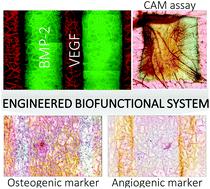当前位置:
X-MOL 学术
›
Biomater. Sci.
›
论文详情
Our official English website, www.x-mol.net, welcomes your feedback! (Note: you will need to create a separate account there.)
Spatial immobilization of endogenous growth factors to control vascularization in bone tissue engineering.
Biomaterials Science ( IF 6.6 ) Pub Date : 2020-05-06 , DOI: 10.1039/d0bm00087f Marta R Casanova 1 , Catarina Oliveira 1 , Emanuel M Fernandes 1 , Rui L Reis 2 , Tiago H Silva 1 , Albino Martins 1 , Nuno M Neves 2
Biomaterials Science ( IF 6.6 ) Pub Date : 2020-05-06 , DOI: 10.1039/d0bm00087f Marta R Casanova 1 , Catarina Oliveira 1 , Emanuel M Fernandes 1 , Rui L Reis 2 , Tiago H Silva 1 , Albino Martins 1 , Nuno M Neves 2
Affiliation

|
The intimate crosstalk between endothelial and bony cells is essential for the reconstruction of bone tissue defects. Indeed, a successful bone repair is greatly dependent on the formation of new blood vessels, to ensure the supply of nutrients and gases, as well as the removal of metabolites. Bone morphogenetic proteins (BMPs) and vascular endothelial growth factor (VEGF) are involved on cells differentiation and bone vascularization aiming to develop viable bone tissue. Herein it is hypothesized that endogenous BMP-2 and VEGF bound in a parallel arrangement over a single nanofibrous substrate (NFM) can lead to a successful osteogenic and angiogenic differentiation of mesenchymal stem cells. For that, an engineered biofunctional system was developed comprising anti-BMP-2 and anti-VEGF antibodies, immobilized over an electrospun NFMs in a parallel pattern design, with the attempt to recreate the vasculature of bone tissue. The osteogenic and angiogenic potential of this engineered biofunctional system was demonstrated by culturing human bone marrow-derived mesenchymal stem cells (hBM-MSCs) during 21 days without exogenous induction. A chick chorioallantoic membrane (CAM) assay showed that the engineered biofunctional system, comprising bound endogenous BMP-2 and VEGF, is able to induce an increased angiogenic response. The angiogenic ability of this system, together with the osteogenic inductor BMP-2, enable obtaining an effective vascularized bone tissue engineering approach.
中文翻译:

空间固定内源性生长因子以控制骨组织工程中的血管形成。
内皮细胞与骨细胞之间的亲密串扰对于重建骨组织缺损至关重要。实际上,成功的骨修复在很大程度上取决于新血管的形成,以确保营养和气体的供应以及代谢物的去除。骨形态发生蛋白(BMP)和血管内皮生长因子(VEGF)参与细胞分化和骨血管形成,旨在发展可行的骨组织。本文假设在单个纳米纤维底物(NFM)上以平行排列结合的内源性BMP-2和VEGF可导致间充质干细胞成功的成骨和血管生成分化。为此,开发了一种工程化的生物功能系统,其中包含抗BMP-2和抗VEGF抗体,以平行模式设计固定在电纺NFM上,试图重建骨骼组织的脉管系统。通过在没有外源诱导的情况下培养21天的人类骨髓源间充质干细胞(hBM-MSC),证明了该工程生物功能系统的成骨和血管生成潜力。鸡绒膜尿囊膜(CAM)分析表明,包含结合的内源性BMP-2和VEGF的工程化生物功能系统能够诱导增加的血管生成反应。该系统的血管生成能力与成骨诱导剂BMP-2一起,能够获得有效的血管化骨组织工程方法。通过在没有外源诱导的情况下培养21天的人类骨髓源间充质干细胞(hBM-MSC),证明了该工程生物功能系统的成骨和血管生成潜力。鸡绒膜尿囊膜(CAM)分析表明,包含结合的内源性BMP-2和VEGF的工程化生物功能系统能够诱导增加的血管生成反应。该系统的血管生成能力与成骨诱导剂BMP-2一起,能够获得有效的血管化骨组织工程方法。通过在没有外源诱导的情况下培养人骨髓来源的间充质干细胞(hBM-MSC)21天,证明了该工程生物功能系统的成骨和血管生成潜力。鸡绒膜尿囊膜(CAM)分析表明,包含结合的内源性BMP-2和VEGF的工程化生物功能系统能够诱导增加的血管生成反应。该系统的血管生成能力与成骨诱导剂BMP-2一起,能够获得有效的血管化骨组织工程方法。能够诱导增加的血管生成反应。该系统的血管生成能力与成骨诱导剂BMP-2一起,能够获得有效的血管化骨组织工程方法。能够诱导增加的血管生成反应。该系统的血管生成能力与成骨诱导剂BMP-2一起,能够获得有效的血管化骨组织工程方法。
更新日期:2020-03-23
中文翻译:

空间固定内源性生长因子以控制骨组织工程中的血管形成。
内皮细胞与骨细胞之间的亲密串扰对于重建骨组织缺损至关重要。实际上,成功的骨修复在很大程度上取决于新血管的形成,以确保营养和气体的供应以及代谢物的去除。骨形态发生蛋白(BMP)和血管内皮生长因子(VEGF)参与细胞分化和骨血管形成,旨在发展可行的骨组织。本文假设在单个纳米纤维底物(NFM)上以平行排列结合的内源性BMP-2和VEGF可导致间充质干细胞成功的成骨和血管生成分化。为此,开发了一种工程化的生物功能系统,其中包含抗BMP-2和抗VEGF抗体,以平行模式设计固定在电纺NFM上,试图重建骨骼组织的脉管系统。通过在没有外源诱导的情况下培养21天的人类骨髓源间充质干细胞(hBM-MSC),证明了该工程生物功能系统的成骨和血管生成潜力。鸡绒膜尿囊膜(CAM)分析表明,包含结合的内源性BMP-2和VEGF的工程化生物功能系统能够诱导增加的血管生成反应。该系统的血管生成能力与成骨诱导剂BMP-2一起,能够获得有效的血管化骨组织工程方法。通过在没有外源诱导的情况下培养21天的人类骨髓源间充质干细胞(hBM-MSC),证明了该工程生物功能系统的成骨和血管生成潜力。鸡绒膜尿囊膜(CAM)分析表明,包含结合的内源性BMP-2和VEGF的工程化生物功能系统能够诱导增加的血管生成反应。该系统的血管生成能力与成骨诱导剂BMP-2一起,能够获得有效的血管化骨组织工程方法。通过在没有外源诱导的情况下培养人骨髓来源的间充质干细胞(hBM-MSC)21天,证明了该工程生物功能系统的成骨和血管生成潜力。鸡绒膜尿囊膜(CAM)分析表明,包含结合的内源性BMP-2和VEGF的工程化生物功能系统能够诱导增加的血管生成反应。该系统的血管生成能力与成骨诱导剂BMP-2一起,能够获得有效的血管化骨组织工程方法。能够诱导增加的血管生成反应。该系统的血管生成能力与成骨诱导剂BMP-2一起,能够获得有效的血管化骨组织工程方法。能够诱导增加的血管生成反应。该系统的血管生成能力与成骨诱导剂BMP-2一起,能够获得有效的血管化骨组织工程方法。


























 京公网安备 11010802027423号
京公网安备 11010802027423号